VIA's QuadCore: Nano Gets Bigger
by Anand Lal Shimpi on May 12, 2011 3:01 AM ESTThe Tour
While this trip to Centaur wasn't my first visit to Austin, it was the first time I had ever visited VIA's x86 CPU division. VIA acquired Centaur 12 years ago, Glenn Henry has been there since the beginning - back when the company was made up of only 4 people.
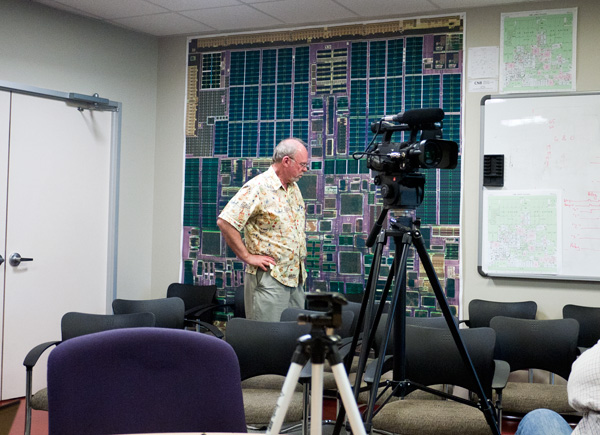
Centaur's Glenn Henry in front of a giant dual-core Nano die shot
Glenn took us all on a tour of Centaur. The company itself has 101 employees, a number that grew from 70 at the time of the VIA acquisition. Glen insists that in order to compete in this market with much more powerful competitors (AMD:Centaur::Intel:AMD) his operation has to be lean and efficient. Everyone likes to say that, but Glen actually showed me proof.
When designing a microprocessor you don't just come up with an architecture and hope it works. You do tons of simulation. First you simulate in software. You build up a C model of parts of your architecture or the entire architecture if possible and run it against datasets. This is how you determine things like cache sizes, balance of resources, and model even more fundamental architectural decisions. When you get further along you'll actually simulate the hardware on large FPGAs or other systems with similar functionality. The idea at this point is less about performance validation but just functional validation. The road to manufacturing is expensive (silicon masks cost a lot of money) and time intensive (from tapeout to first silicon is at least 2 months), so you want to figure out as much about your chip's performance and functionality/bugs ahead of time.
Visit any chip company and you'll find a server farm. Dozens if not hundreds of networked PCs all designed to do simulation and validation tests on chip designs. Intel, AMD, NVIDIA, they've all got them. I remember visiting NVIDIA's validation labs and being told that they are limited by the amount of physical power they can get to the lab so each server upgrade has to provide better power efficiency.
Glen took me on a tour of Centaur's simulation lab. To say it was a different experience would be an understatement. While some machines were racked, there were a lot of desktop motherboards running Core i5s and Core i7s running out of cases:
The systems that were in cases were water cooled Core i7s, overclocked to 5GHz. There are two folks at Centaur who build each and every one of these machines, and overclock them. You and I know that overclocking both Nehalem and Sandy Bridge results in much better performance for the same dollar amount, but this is the first time I've seen overclocking used to speed up the simulation of microprocessors.
There are similar efforts made all over Centaur. If something can be built more cheaply than it can be bought, Centaur takes the more affordable route. Even Centaur's ovens used for thermal stress testing use a lot of Centaur-built components in order to reduce their total purchase cost to one fifth of what they would be.
While Centaur didn't have a wafer saw on hand, it can solder and package its own die. This station was used to package a dual-core Nano while a number of journalists watched:
I do wonder about Centaur's future especially as its message of low power operation is now front and center with the current smartphone revolution taking place. In the early days Centaur had to convince users that power was important and that performance was good enough. These days the convincing isn't necessary; it's more about execution, vendor relationships and all of the other pieces of the integrated puzzle. Can VIA and Centaur play a more significant role in the future? The ingredients are there, the question is whether or not VIA is willing to take the risk to give it a try.



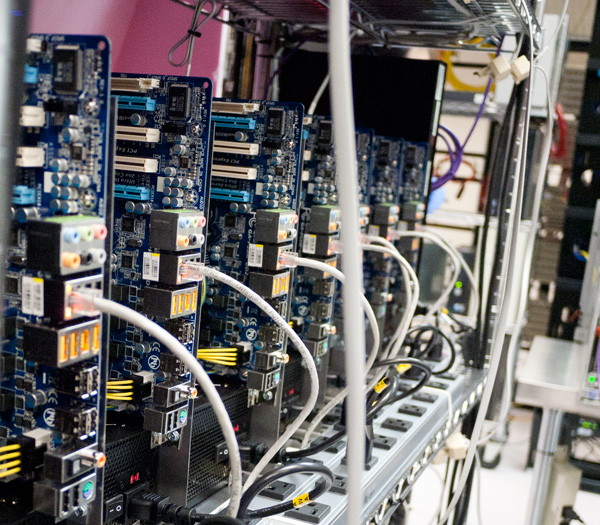
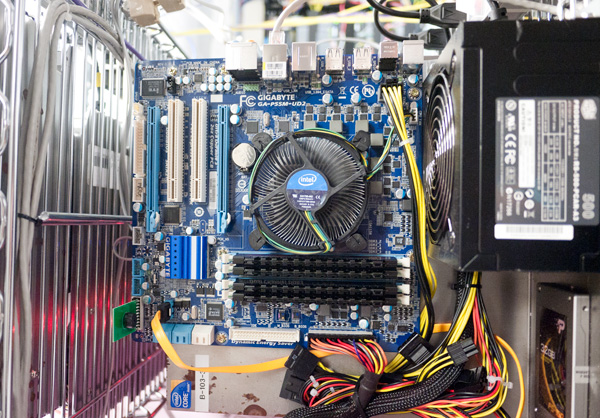
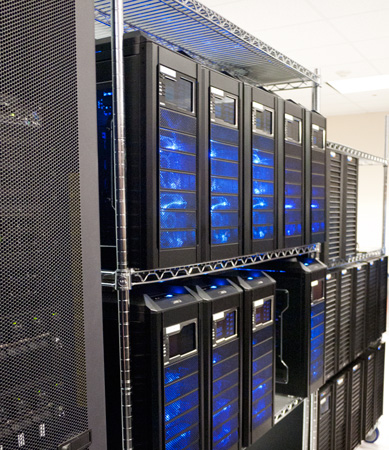
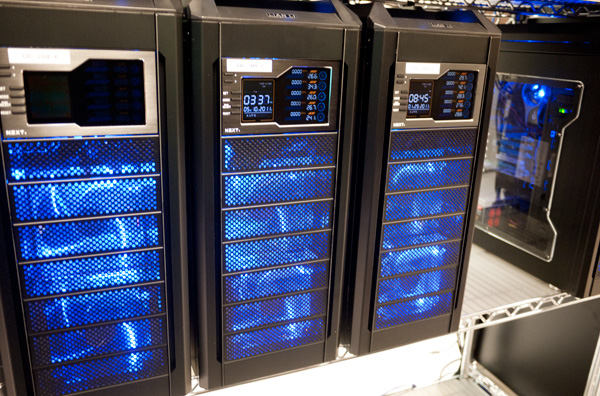


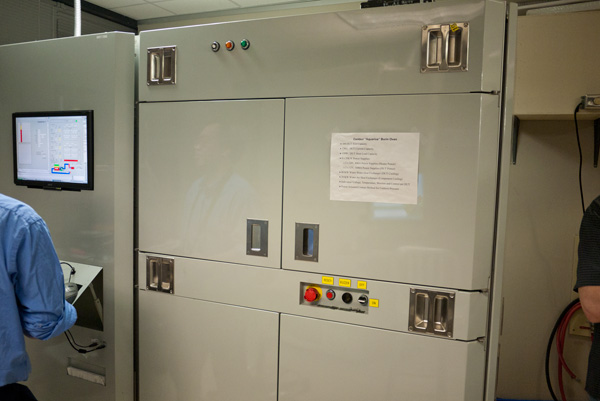
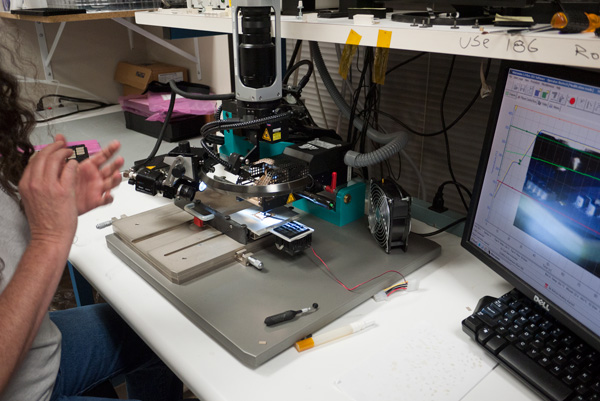
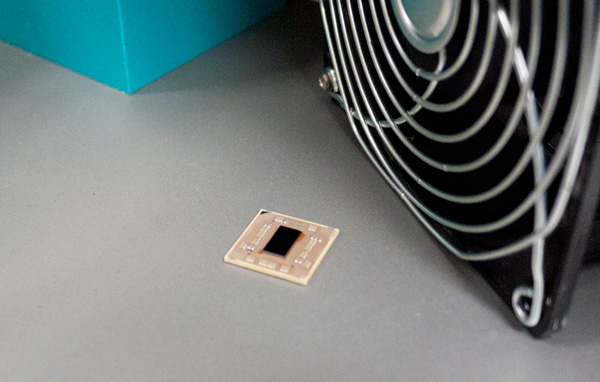








36 Comments
View All Comments
wordsworm - Thursday, May 12, 2011 - link
really, would make a good partnership.tipoo - Thursday, May 12, 2011 - link
Agreed, although I'm not sure VIA's x86 license would carry over in a buyout. In any case, Nvidia is going to be doing some neat things with ARM, with what looks like a cell-like chip in which a high performance ARM core (or more) controls many CUDA cores, that sounds like it has potential.rahvin - Thursday, May 12, 2011 - link
If the Via x86 License was transferable then nVidia would have bought them a year ago when they made all the waves about x86 licenses. All indications are that if Via changes hands again the x86 license goes away. There are also indications that when it changes hands last time Intel added some conditions about how Via could use the license at least that's my opinion. IMO Via's limited themselves to certain market segments that at the time of the last transfer Intel wasn't interested in. This may simply be economics but I also think it's possible that they are contractually limited to those areas from conditions Intel extracted during the last transfer of the Centuar group.Anyway, my main point is that it's pretty common knowledge that if Centaur trades hands again the x86 license is gone making the division worth nothing on the open market. If Via/S3 can't make the business work they will simply evaporate unless they can get the government to force Intel to make the sale possible.
gayannr - Thursday, May 12, 2011 - link
I wonder what AMD is using for their simulations ? i7 ? :)qwertymac93 - Thursday, May 12, 2011 - link
nah, probably magny cours.Prosthetic Head - Thursday, May 12, 2011 - link
AMD will almost certainly be using their own chips. I am a computational chemist and regularly run large simulations on HPC facilities. Most of these use AMD chips. For example the HECToR machine built using Cray XE6 units uses 44,544 cores worth of 12-core AMD Opteron 2.1GHz Magny Cours processors.AMD do very well in the HPC space.
Prosthetic Head - Thursday, May 12, 2011 - link
Oh and the spec of the machines next upgrade has just been confirmed:"The solution supplied will be a 30 cabinet system utilising the next generation AMD Interlagos processor and Cray's Gemini interconnect. The machine will have a projected theoretical peak of 820TF and as such represents a greater than two-fold increase in capability over the current Phase 2b system."
tipoo - Thursday, May 12, 2011 - link
I'll reserve my judgement, but right now I can't see this being competitive at all. Its basically the dual core variant with two dual-core chips glued together, and only minor architectural tweaks. Add in the required graphics that it doesn't have, and its power consumption will be much higher than Brazos as the article says. I can't see a segment it would be better in, its kind of the awkward middle child between processors for ultramobiles and processors for netbooks, it doesn't really fit the bill of either.Interesting chart, are Atoms finally more powerful than a Pentium 4 2.66GHz now? AMD's even more so. Not bad.
L. - Monday, May 23, 2011 - link
And that's without considering that Brazos is going to be 32nm sometime soon -- poor VIA they never could make anything useful could they ?Soulkeeper - Thursday, May 12, 2011 - link
One of the better articles i've read in awhile.Nice to see a small company like via rolling up their sleeves and making cpu's "24 at a time" to compete with the monster intel.
the extra 2 cores + beefed up padlock is very interesting
i'd be interested in seeing how that competes with i7